In this post, as a Welding Engineer expertise, I have covered complete procedure for successful Welding ASTM A335 P11 or ASTM A387 Gr.11 or commonly known as 1.25Cr-0.5 Mo P11 Steel. I have covered selection of welding rods as per ASME codes, preheat & interpass temperature, PWHT procedure and details about the base material.
What is P11 Material?
P11 material or T11 or F11 or ASTM A387 Gr. 11, also known as 1.25Cr-0.5 Mo (UNS No.: K11597) is a high-temperature low alloy steel material used mainly in power plants, oil & gas fields for the fabrication of pressure vessels, columns, and pipelines as per ASME Section IX, Section 1 and B31.3, etc.
Chromium (Cr) as an alloying element in this steel, provides elevated-temperature strength, improved oxidation resistance at high temperatures, and increases the tensile strength, yield strength & material hardness.
Molybdenum (Mo) in P11 material rises the load-bearing capacity, Yield strength, hardness, and toughness properties. The Steel alloy contains 1.25% chromium and 0.5% Molybdenum thus the name is given as 1 1/4Cr-1/2Mo.
If the material is supplied in pipe form it is designated as P11, in forging it is called F11, wrought fitting is W11, and casting is WC6.
- B11: Bar
- F11: Forging
- T11: Seamless tube
- WC6: Casting
- P11: Pipe
P11 Material Specification
P11 material specification is A335 for pipe, A213 for Tube, A234 for wrought fitting, for forging A182, For casting A217, and for plate, the material is A387 as shown in the below table.
| Specification | Material Form | Grade |
|---|---|---|
| ASTM A335 | Pipes | P11 |
| ASTM A213 | Tubes | T11 |
| ASTM A234 | Fittings | W11 |
| ASTM A182 | Forging | F11 |
| ASTM A217 | Casting | WC6 |
| ASTM A387 | Plate | Grade 11 |
Chemical and mechanical properties of P11 material
The chemical and mechanical properties of P11 material are important to consider when selecting a material for a specific application.
Detailed chemical & mechanical properties of most widely used ASTM A335 P11 (SA335 P11 chemical composition) material are given in the below table:
| Element | % Composition |
|---|---|
| Carbon | 0.05- 0.15 |
| Chromium | 1.0- 1.50 |
| Molybdenum | 0.44- 0.65 |
| Manganese | 0.30- 0.60 |
| Silicon | 0.50- 1.0 |
| Sulfur | 0.025 Max |
| Phosphorus | 0.025 Max |
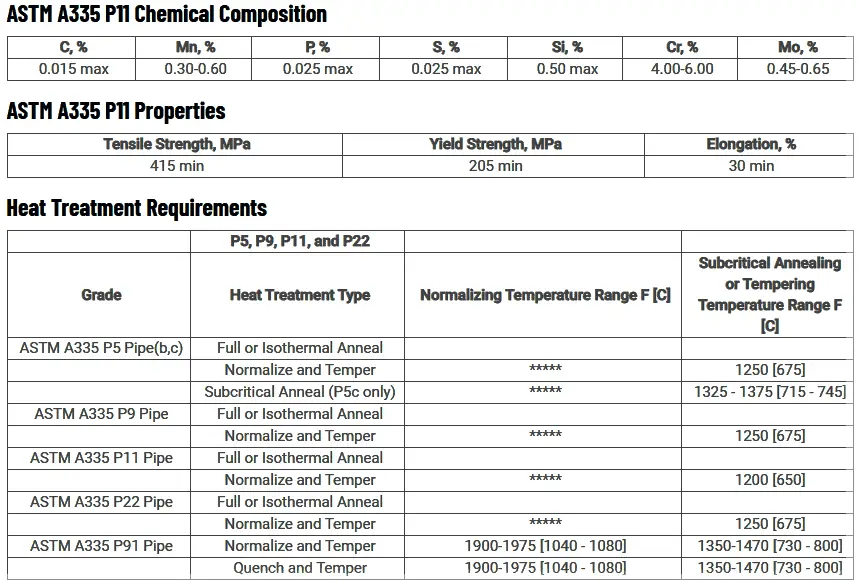
Welding P11 Material
P11 Material or 1.25Cr-0.5Mo is known for its high strength and resistance to wear at high temperature applications. The welded joint of P11 material need to be as strong as the base metal and same resistance to oxidation.
In order to achieve a weld that is strong with optimum properties, the following steps should be followed:
- The pieces of metal to be welded should be cleaned and free of any contaminants.
- The welding area should be prepped by using a wire brush or grinder to remove any paint or rust.
- A welding rod that matches the composition of the base metal should be selected.
- The welding process should be performed using a steady hand and proper technique.
- The welded joint should be allowed to cool slowly in order to avoid cracking.
P11 Material Welding Electrode
As a Welding Engineer, my recommendation is to choose the best welding rod for P11 material. SMAW or stick welding of P11 material is carried out using E8018-B2 (Low alloy low hydrogen electrodes). E8018-B2 gives the weld deposit (refer table below) as the base metal and matching base metal properties.
| Element | Carbon (C) | Manganese (Mn) | Silicon (Si) | Sulfur (S) | Phosphorus (P) | Chromium (Cr) | Molybdenum (Mo) | Nickel (Ni) | Copper (Cu) |
|---|---|---|---|---|---|---|---|---|---|
| Percentage | 0.10 max | 0.50-0.90 | 0.30-0.65 | 0.030 max | 0.025 max | 1.00-1.50 | 0.45-0.65 | 0.40 max | 0.50 max |
The E8018-B2 welding electrode is a versatile, low-alloy electrode that can be used for welding a variety of metals. It produces high-quality welds with low levels of spatter, making it an ideal choice for use in a variety of applications.
Additionally, the E8018-B2 electrode is available in a number of different sizes, making it easy to find the perfect fit for your needs.
TIG or MIG welding is carried out using ER80S-B2 filler wire (refer table below for ER80S-B2 chemical compositions). The SMAW electrodes need to be baked before the welding. Click below for low hydrogen electrodes baking requirements.
| Element | Carbon (C) | Manganese (Mn) | Silicon (Si) | Sulfur (S) | Phosphorus (P) | Chromium (Cr) | Molybdenum (Mo) | Nickel (Ni) | Copper (Cu) |
|---|---|---|---|---|---|---|---|---|---|
| Percentage | 0.08 max | 0.70-1.10 | 0.45-0.75 | 0.030 max | 0.030 max | 0.90-1.40 | 0.40-0.65 | 0.15 max | 0.50 max |
P11 welding filler wire
P11 welding filler wire are ER80S-B2, ER80S-B3, ER90S-B3 and E9XT1-B3C. ER80S-B3 and ER90S-B3 are TIG & MIG welding filler wires used for welding of P11 material to itself, P11 to P22 and P11 to Carbon steel welding.
E9XT1-B3C is low alloy wire used for welding of P11 material by Flux Cored arc welding (FCAW).
Gas shielding is required for welding of ER80S-B2, ER80S-B3, ER90S-B3 and E9XT1-B3C. Pure argon is used for tig welding while argon-CO2 mix is used with MIG welding.
What is Low Hydrogen electrodes, Their Storage & Baking Procedure?
The typical minimum weld metal deposit chemistry and mechanical properties of E8018-B2 are given in the below table.
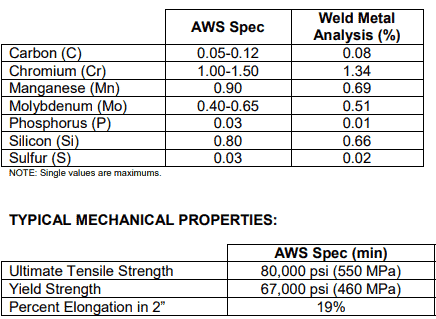
Preheating and interpass temperature for P11 Welding
Welding preheat for Cr-Mo steel is important to achieve the desired properties in the welded joint.
The temperature of the weldment must be raised above the minimum required preheat temperature for the base metal, and maintained at that temperature until the welding process is complete.
Preheating can be accomplished by heating the welding joint & surrounding area. Preheat control shall be placed in to ensure application of right preheat temperature.
Welders have long been familiar with the need for preheat when welding carbon steel. The addition of chromium and molybdenum to the alloy changes the behavior of the steel, making it more prone to cracking.
Preheating and interpass temperature for P11 Welding is very critical as the weld metal is air hardenable. If proper preheating is not applied, the weld will be hardened and can get hydrogen cracking.
The minimum Preheat temperature of 250 °F (120 °C) shall be applied during the welding.
Try our Online Welding Preheat Calculator for Free.
The interpass temperature is kept at a maximum of 600 °F (315 °C) for P11 material welding.
Postweld Heat Treatment for ASTM A335 P11 pipes
When it comes to ASTM A335 P11 pipes, which are seamless pipes made of low-alloy steel, they can be utilized for power piping (ASME B31.1) or process piping (ASME B31.3) at elevated temperatures. However, after joining two ASTM A335 P11 pipes together through a welding process, it is necessary to undergo postweld heat treatment (PWHT).
This PWHT serves multiple purposes, including preventing or alleviating the adverse effects caused by high temperatures and significant temperature variations inherent in welding. Additionally, it aims to relieve residual stresses that may have been generated during the welding operation.
The specific guidelines for the PWHT should be included in the Welding Procedure Specification, which must adhere to the essential variables outlined in ASME BPVC, Section IX. These essential variables ensure that the PWHT is carried out in compliance with the relevant standards and procedures specified by ASME.
PWHT requirement for P11 material
PWHT for P11 or common Cr-Mo steel is a process that is often used to help improve the mechanical properties of the steel. The process helps to relieve residual stress, and can also help to improve the microstructure of the steel.
The PWHT process can be performed in a variety of ways, including through local PWHT or full PWHT in furnace, or even using induction heating. Post heating or PWHT of P11 welding is carried out at 650 °C to 705 °C (1,200 °F to 1,300 °F). The holding time is kept at 1 h/25 mm (1 hr/in.) and 15 minimum (Ref: API 582).
PWHT for Cr-Mo steel is a critical step in the manufacturing process to ensure the steel’s properties are met. The steel must be heated to a certain temperature and then cooled slowly.
This process helps to prevent any micro-cracks from forming in the steel & reduces the residual stresses, which could lead to failure down the road.
PWHT Requirements
As per ASME BPVC Section IX QW/QB – 420, ASTM A335 Gr. P11 (UNS K11597) has been assigned a P-number of 4 and a Group number of 1.
The determination of the post-weld heat treatment (PWHT) zone is based on the following criteria:
“in all directions from the welding point, for a distance that is either 75 mm or 1.5 times the greater nominal wall thickness, whichever is larger.”
The PWHT zone needs to be heated within a temperature range of 650°C [1200°F] to 705°C [1300°F] and maintained at this temperature for a specific duration.
The minimum holding time, denoted as ‘t’ (in hours), is determined by the pipe’s control thickness, indicated as ‘T’ (in mm). If ‘T’ is equal to or less than 50 mm, ‘t’ is calculated as T/25, with a minimum value of 1/4 hour. If ‘T’ is greater than 50 mm, ‘t’ is calculated as [2 + 0.25 × (T – 50) / 25].
During the construction process, the post-weld heat treatment for ASTM A335 P11 pipes is typically carried out using an electric-resistance method, such as the flexible ceramic pad heater. It is important to ensure that the heating and cooling rate during the PWHT process does not exceed 335°C/hour [600°F/hour], divided by half of the maximum material thickness in inches at the weld. However, under no circumstances should the rate exceed 335°C/h [600°F/h].
Hardness Limit of P11 Weldments
In accordance with ASME B31.3, the weldments of ASTM A335 P11 pipes are required to have a Brinell hardness limit of 225 after post-weld heat treatment (PWHT). This specification ensures the weld’s mechanical properties are within an acceptable range. However, it’s important to note that in the latest version of ASME B31.3, hardness tests are not mandatory unless otherwise specified in the engineering design.
Welding P11 to Carbon Steel
Welding of P11 to Carbon Steel can be carried out using SMAW or stick welding with E7018 or E8018-B2. E8018-B2 is recommended to provide better weldment properties compare to E7018.
TIG or MIG welding of P11 is carried out using ER70S-6 or ER80S-B2 filler wire.
Welding P11 to P22 and P91
Welding of P11 to P22 can be carried out using SMAW or stick welding with E8018-B3 or E8018-B2. E8018-B3 is recommended. TIG or MIG welding of P11 is carried out using ER90S-B3 or ER80S-B2 filler wire.
P11 to P91 welding is carried out using E8018-B8 or ER80S-B8 filler wire.
Is P11 to Stainless Steel(304L or 316L) welding possible?
To prevent hot cracking caused by low ferrite number (FN), you can use ERNiCr-3/ENiCrFe-3 (also known as Alloy 82) filler wire. This filler wire is recommended for its high nickel content, which helps maintain a higher FN and reduces the risk of hot cracking.
If your P11 pipe requires post-weld heat treatment (PWHT) due to its thickness, a recommended approach is to use a buttering technique. This involves applying a layer of 309 grade filler metal onto the P11 pipe before performing the PWHT. After the PWHT process, you can then weld the buttered P11 pipe to the 316 stainless steel using the 309 filler metal once again.
P11 to P22 welding electrode
Read more: P22 Material Welding Guide
P11 to P22 welding electrodes are:
- E8018-B3, E8015-B3, E8016-B3, E9018-B3 (For stick welding applications)
- ER80S-B3, ER90S-B3 (For TIG & MIG Welding),
- E9XT1-B3C (For flux cored arc welding)
P11 to P22 welding electrodes are classified in AWS A5.5 for stick welding, AWS A5.28 for TIG & MIG Welding and AWS A5.29 for flux cored arc welding.
Difference between P11 and P22 material
Both P11 and P22 material are Chrome-Moly alloy materials used for high temperature (elevated) service. Although, both has differences in chemistry and other properties as listed below:
- P11 contains 1.25%Cr-0.5%Mo, while P22 contains 2.25%Cr-1%Mo.
- Both materials has same mechanical strength.
- P11 service temperature limit is less compared to P22 material.
- P22 material has higher hardness compare to P11 material.
- P22 creep strength is higher than P11 material.
Welding Guidelines for ASTM A335 P11
- Before welding ASTM A335 P11 pipes:
- Preheat welding electrodes carefully at 300~350°C for 1 hour.
- Preserve electrodes at a temperature of 80~120°C.
- Avoid thermal shock or quenching during preheating to prevent coating cracking.
- Clean off any rust or oil stains before welding.
- Tack welding:
- Use Gas Arc Welding (GAW) as the method.
- Grind the positioning weld seam.
- Apply a minimum of 4 evenly distributed tack welds along the circumference.
- Preheat before tack welding.
- Considerations during welding:
- Control and consider the environment.
- Cover both ends of the pipe to prevent excessive wind flow.
- Maintain humidity rate below 90%.
- Control natural wind flow to less than 8 m/s or 2 m/s for SMAW or GTAW.
- Interpass temperature:
- Sustain at a temperature not lower than the preheating temperature.
- Post-weld heat treatment (PWHT):
- Perform a post-weld heating process if PWHT is not immediate:
- Keep at 300~350°C for 30 minutes.
- Gradually cool down to room temperature.
- Perform a post-weld heating process if PWHT is not immediate:
- PWHT preheating:
- Consider the following factors:
- Heating temperature: 600~675°C.
- Heating rate: 95°C/h.
- Preservation time: 2.5 hours.
- Cooling rate: 110°C/h.
- Heating width: L≥600 mm.
- Consider the following factors:
- Hardness requirement:
- After PWHT, the hardness of weld seam and heat-affected zones should not exceed 225 HB.
Similar Posts:
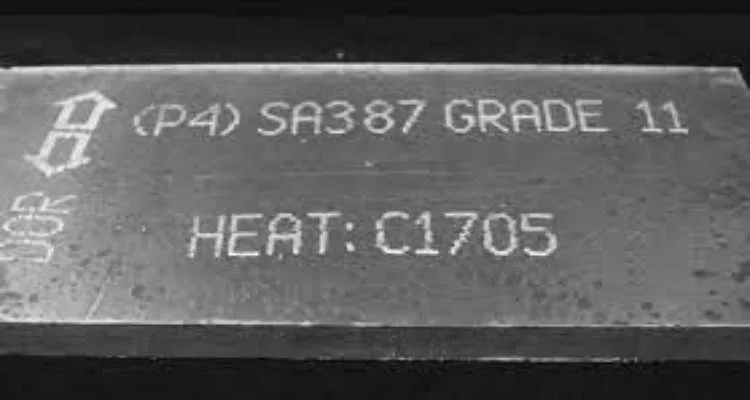
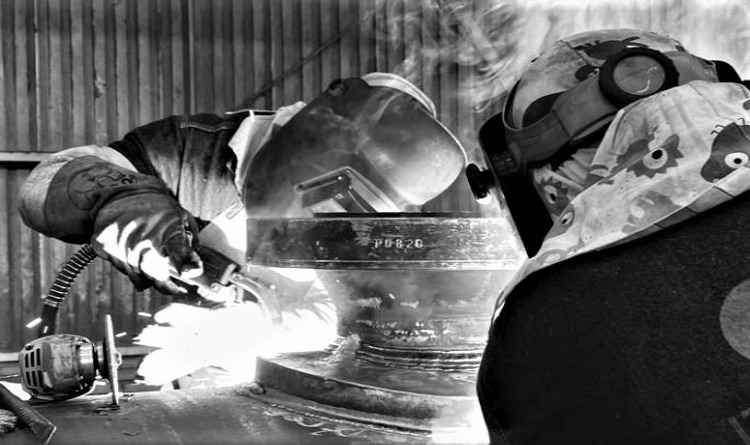
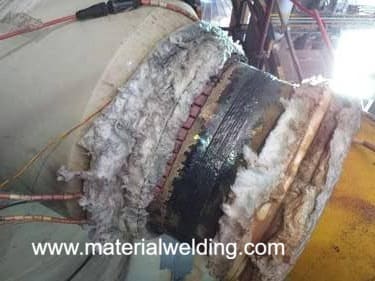
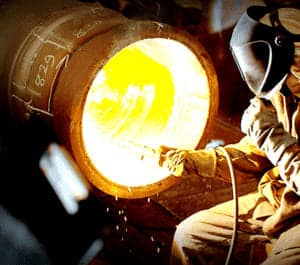
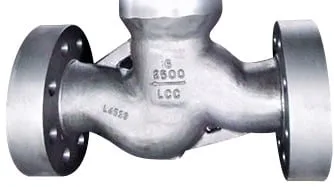
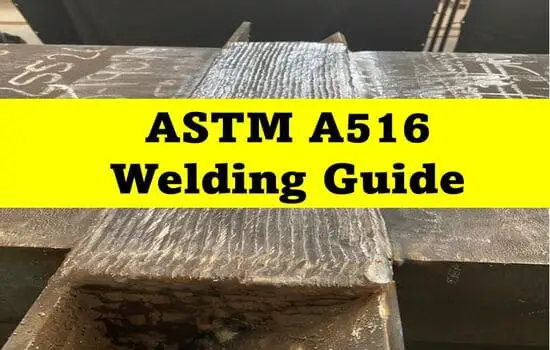
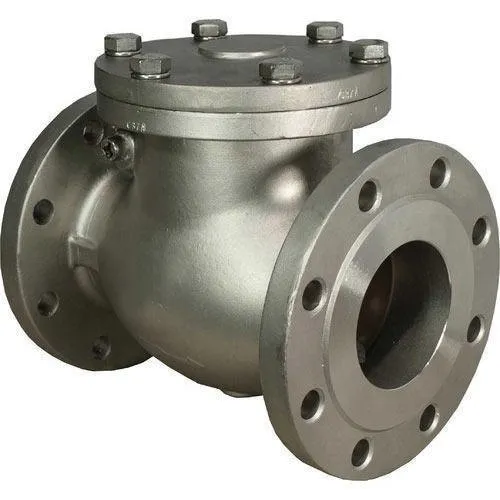
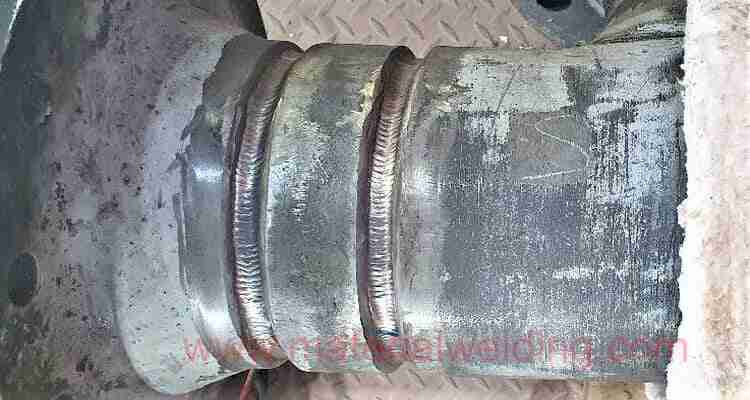
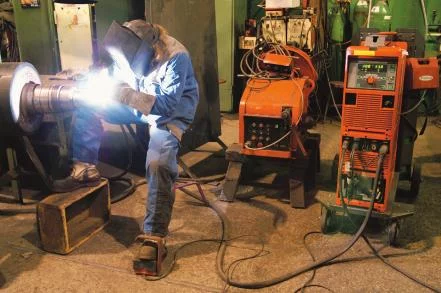

Thank you for this detailed article on welding P11 material, as well as welding P11 grades to other materials. Really very helpful for all engineers.
Which welding rod is best for welding P11 pipe material?